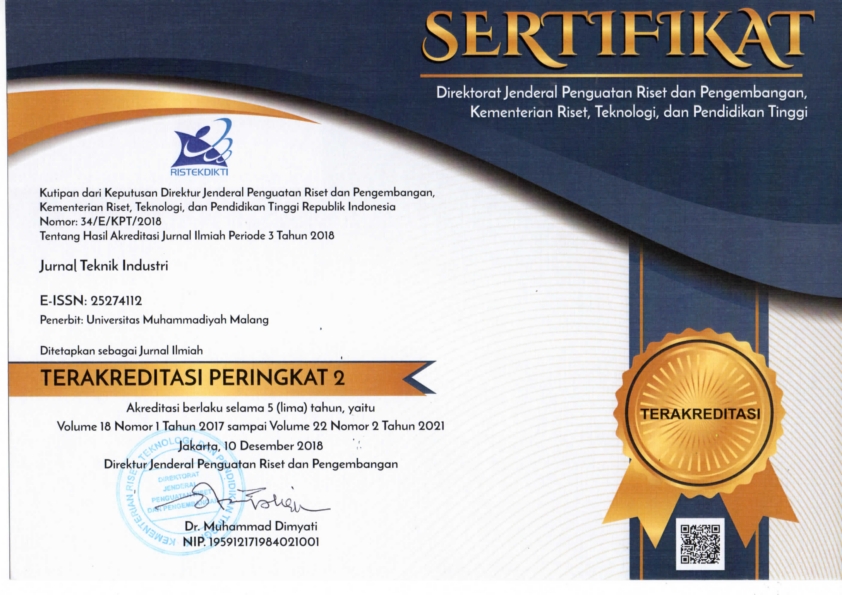Improve Algoritma Hodgson Untuk Meminimasi Jumlah Job Terlambat Pada Penjadwalan Flow shop
DOI:
https://doi.org/10.22219/JTIUMM.Vol19.No1.73-81Keywords:
Flow shop, The number jobs of tardy, HudgsonAbstract
Since Johnson published a paper in 1954, the problem of job scheduling has received the attention of hundreds of practitioners and researchers, as one of the most studied topics in Operation research. Several heuristic studies have discussed the problem of flow shop scheduling to minimize the completion time (makespan). In this paper, we consider the problem of pure flow shop scheduling to minimize the number of jobs of tardy. We have developed a Hudson algorithm for minimization solution the number jobs of tardy. Hodgson's improved Heuristic algorithm was tested and compared to the EDD priority rule. The Numerical experimental results show the new algorithm provides a better solution than priority EDD. The improving Hodgson algorithm gives a minimum number of tardy jobs.Downloads
References
K. R. Baker and D. Trietsch, Principles of sequencing and scheduling: John Wiley & Sons, 2013.
M. L. Pinedo, Scheduling: theory, algorithms, and systems: Springer Science & Business Media, 2012.
S. Harto, A. K. Garside, and D. M. Utama, "penjadwalan produksi menggunakan algoritma jadwal non delay untuk meminimalkan makespan studi kasus di cv. Bima mebel," Spektrum Industri, vol. 14, 2016.
M. Husen, I. Masudin, and D. M. Utama, "Penjadwalan Job Shop Statik Dengan Metode Simulated Annealing Untuk Meminimasi Waktu Makespan," Spektrum Industri, vol. 13, 2015.
K. R. Baker, Introduction to sequencing and scheduling: John Wiley & Sons, 1974.
M. Pinedo, Planning and scheduling in manufacturing and services vol. 24: Springer, 2005.
D. M. Utama, "Analisa Perbandingan Penggunaan Aturan Prioritas Penjadwalan Pada Penjadwalan Non Delay N Job 5 Machine," Research Report, vol. 1, 2017.
C. Rajendran, "Heuristic algorithm for scheduling in a flowshop to minimize total flowtime," International Journal of Production Economics, vol. 29, pp. 65-73, 1993.
Y. Li, W. Ip, and D. Wang, "Genetic algorithm approach to earliness and tardiness production scheduling and planning problem," International Journal of Production Economics, vol. 54, pp. 65-76, 1998.
S. M. Johnson, "Optimal two‐and three‐stage production schedules with setup times included," Naval Research Logistics (NRL), vol. 1, pp. 61-68, 1954.
H. G. Campbell, R. A. Dudek, and M. L. Smith, "A heuristic algorithm for the n job, m machine sequencing problem," Management science, vol. 16, pp. B-630-B-637, 1970.
J. N. Gupta, "Heuristic algorithms for multistage flowshop scheduling problem," AIIE Transactions, vol. 4, pp. 11-18, 1972.
D. G. Dannenbring, "An evaluation of flow shop sequencing heuristics," Management science, vol. 23, pp. 1174-1182, 1977.
R. Logendran and N. Nudtasomboon, "Minimizing the makespan of a group scheduling problem: a new heuristic," International Journal of Production Economics, vol. 22, pp. 217-230, 1991.
H. D. Pour, "A new heuristic for the n-job, m-machine flow-shop problem," Production Planning & Control, vol. 12, pp. 648-653, 2001.
M. Nawaz, E. E. Enscore, and I. Ham, "A heuristic algorithm for the m-machine, n-job flow-shop sequencing problem," Omega, vol. 11, pp. 91-95, 1983.
I. Masudin, D. M. Utama, and F. Susastro, "Penjadwalan Flowshop Menggunakan Algoritma Nawaz Enscore Ham," Jurnal Ilmiah Teknik Industri, vol. 13, pp. 54-59, 2014.
Z. Lomnicki, "A" branch-and-bound" algorithm for the exact solution of the three-machine scheduling problem," OR, pp. 89-100, 1965.
J. Moore, "Sequencing n jobs on one machine to minimize the number of tardy jobs," Management Science, vol. 15, pp. 102-109, 1968.
J. C. Ho and Y.-L. Chang, "Minimizing the number of tardy jobs for m parallel machines," European Journal of Operational Research, vol. 84, pp. 343-355, 1995.
E. Lodree Jr, W. Jang, and C. M. Klein, "A new rule for minimizing the number of tardy jobs in dynamic flow shops," European Journal of Operational Research, vol. 159, pp. 258-263, 2004.
M. Azizoglu, S. Kondakci, and M. Köksalan, "Single machine scheduling with maximum earliness and number tardy," Computers & Industrial Engineering, vol. 45, pp. 257-268, 2003.
R. M’Hallah and R. Bulfin, "Minimizing the weighted number of tardy jobs on a single machine," European Journal of Operational Research, vol. 145, pp. 45-56, 2003.
R. M’Hallah and R. Bulfin, "Minimizing the weighted number of tardy jobs on a single machine with release dates," European Journal of Operational Research, vol. 176, pp. 727-744, 2007.
S.-S. Li and R.-X. Chen, "Single-machine parallel-batching scheduling with family jobs to minimize weighted number of tardy jobs," Computers & Industrial Engineering, vol. 73, pp. 5-10, 2014.
A. Aydilek, H. Aydilek, and A. Allahverdi, "Algorithms for minimizing the number of tardy jobs for reducing production cost with uncertain processing times," Applied Mathematical Modelling, vol. 45, pp. 982-996, 2017.
C.-C. Wu, W.-C. Lee, and T. Chen, "Heuristic algorithms for solving the maximum lateness scheduling problem with learning considerations," Computers & Industrial Engineering, vol. 52, pp. 124-132, 2007.











